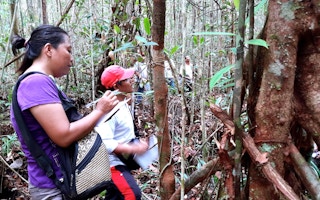The morning after a rainy night, mist enshrouds the lush canopy of the forest at Bawan village. This 1,453-hectare hillock packed with high-value timber sits on the edge of the riverside hamlet in Pulang Pisau district, 80 kilometers (50 miles) due north of the Central Kalimantan capital of Palangkaraya.
Squirrels chase one another through the trees. The shrieks of gibbons fill the air. And the species list of the many wide-diameter trees present reads like an exotic wood catalog in a picture frame shop: meranti, keruing, pelepek, benuas. The towering swamp jelutung trees present are listed by the IUCN as a species of concern.
Yet, the 656-person village of Bawan chose to preserve rather than exploit this grove, which makes up 15 per cent of their 10,000-hectare incorporated village area.
The move is especially surprising because the grove sits in an area zoned by the national government as “production forest.” By regulation Bawan villagers are entitled to 50 cubic meters of wood from this forest annually.
The designation also means they can sell the land to a company to convert into plantation lands, or even a mining pit.
“Five years ago, we got an offer from a palm oil company,” resident Untung Silaing said. “We rejected the offer though. We didn’t want it. If oil palms were planted here, our forest would be reduced to wood shavings.”
Instead, locals applied for a permit to manage the area as a “village forest,” a form of community forestry whereby residents exercise greater control over their land.
Reformist President Joko Widodo has pledged to rezone 12.7 million hectares under the various community forestry schemes — an area bigger than Pennsylvania — although his administration has lagged behind the ambitious target.
“
Five years ago, we got an offer from a plam oil company. We rejected the offer though. If oil palms were planted here, our forest would be reduced to wood shavings.
Untung Silaing, resident, Bawang village
“Over here, we don’t allow tree felling, hunting or poaching,” said Pegun, the head of the local agency set up to oversee the project. He explained that residents see the forest as a place set aside for ecotourism or research.
“In the rare instance that wood is chopped, it has to be for the demonstrated good of many people and the wood cannot leave the forest.” An example project might be a resting gazebo.
Villagers come to the forest to gather non-timber forest products such as rattan, damar latex and honey. “Last month, we had a staff member attend a training on honey harvesting in Cibubur, West Java,” Pegun said. “Our plan is to develop our honey operation into an export business. Everyone loves honey.”
This decision — to conserve the forest for its ecosystem services rather than exploit it — came after a local ecotourism training session.
Perhaps also influential in Bawan’s choice was the fact the forest was originally managed by Palangkaraya University as an educational forest, in a program initiated by the late Suwido Limin, a peat expert who died last year after fighting forest fires. This original designation was abandoned for legal reasons.
Continued management of the forest would of course require funding though — for patrols and trainings for locals to become ecotourism guides. Silaing, who is also with the village forest agency, hopes the state or a nonprofit might provide such funding.
“We don’t yet have a local fire brigade but we plan to form one,” said Bawan village secretary Lilis Suryanie, noting that most of the members of the forest agency are rubber farmers who have groves in the village forest’s buffer zone.
Lilik Sugiarti, who works for USAID’s Katingan-Kahayan landscape program, said that she, for one, was surprised and appreciative of the Bawan village rule prohibiting the chopping of trees despite being within a production forest zone.
“I consider Bawan’s village forest a champion project. They have a high understanding of the importance of environmental preservation,” she said. “At first, people here had no concept of non-timber forest products, ecotourism, or the value of the environment.
But the village government, the Bawan forest agency and the people of Bawan themselves chose to protect this area.”
Sugiarti praised the village administration for budgeting 200 million rupiah ($15,000) to build a road to the forest. “The village secretary said that he is suggesting that the district government maintain the road to the forest. If the proposal is rejected, the secretary said he will take funds out of village funds. This is a good example for other village forest agencies.”
In fact, at the end of 2015, inspired by Bawan’s example, the Banama Tingang area regional forestry office named six “potential” other village forests to designate nearby: those of Hurung (481 hectares), Lawang Uru (216 hectares) Pangi (145 hectares) Tambak (590 hectares) Tangkahen (357 hectares) and Tumbang Tarusan (1,111 hectares).
The initiative is being pushed forward by USAID and the Pulau Pisau regional plantation and forestry office as well as local nonprofits such as the Central Kalimantan Community Forestry Group (Pokker SHK), Teropong Foundation, Tahanjungan Tarung Foundation and Cakrawala Indonesia Foundation.
Nisfu Kusuma Restu, the head of the conservation and rehabilitation division of the Pulang Pisau forestry office, said the ratification of the other six forests could be accelerated if there was collaboration among all parties.
“Collaboration is key,” he said. “President Joko Widodo wants to reallocate 12.7 million hectares into social forestry. Citizens also must be active in this effort.”
This story was reported by Mongabay’s Indonesia team and was first published on the Indonesian site on October 25, 2016 and is republished with permission.










